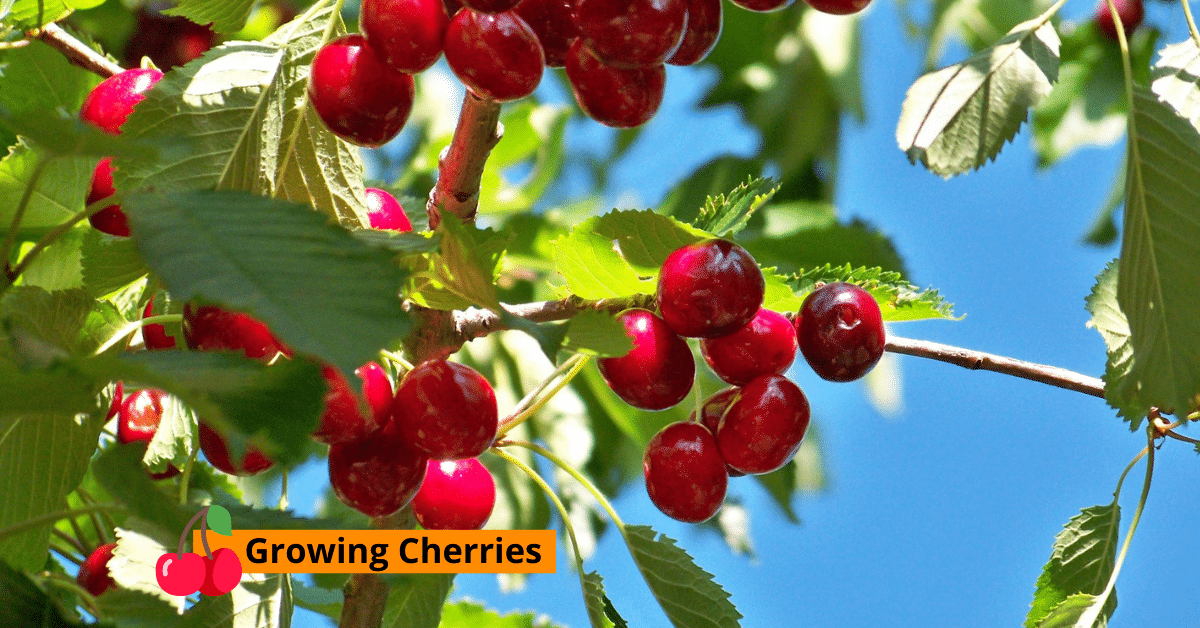Growing cherries, Cherry trees are a sight to behold during the spring when the entire gets lit up by the white and pink blossoms. Once they bloom, the plant starts fetching the delicious cherries for consumption. They belong to the Prunus family, and the fruits they bore are called drupe fruit. There are two types of cherries available in the market commercially, the sweet Prunus avium and the sour Prunus cerasus. Another variant called Wild cherry gets grown naturally out of controlled cultivation.
Overview of Cherries:
Biological Name
Prunus
Plant Type
Fruit Plant
Maturity Period
the plant takes about 4-7 years to become ready to bear fruit
Maturity Size
The cherry tree can reach a height of about 35 feet and wide as much as 25 feet
Soil Type
Cherry trees grow best in loamy, well-drained soils
Soil pH
They prefer acidic soil with pH in the range of 6-6.5.
Exposure
The plants require long hours of direct sunlight during their growing days
Hardiness (USDA Zone)
The plant prefers acidic soil with 5.5 pH.
Spacing
The cultivators need to space them in the range of 35-40 feet between two plants.
Bloom Time
the plant blooms during March and early April.
Toxity
Non-Toxic.
Flower Color
They come in bright red with vivid contrast. Some variants often come in yellow color.
Growth Rate
The plant takes about 4-7 years to grow and become ready for harvest.
Native Zone
Cherry plants are native to the northern hemisphere of the globe.
Maintenance
The tree requires very little maintenance; routine watering of the plant, adding mulch to the soil to retain moisture in the ground. Cultivators often use nets to protect the fruit from the attack of birds. Thinning or Pruning cherry tree the plant is not an essential feature for growth.
History:
Growing cherries dates back to 1893 in Michigan, where the first tart cherry orchards got traced in the history books. By the 1900s, the cherry cultivation belt extended from Michigan to the Traverse City area, and gradually, the growing cherry trees’ popularity surpassed all other crops in the region. The Bing Cherry Tree is often considered one of the most popular variants due to its honey-sweet cherries across the globe.
Another variant called the Rainier cherry tree got produced due to the cross between the Bing cherry tree and Van cherry tree in the Washington State University. Bing, Lambert, and Rainier constitute about 95% of the total production in the northwestern region of the United States of America.
Nutritional Facts:
People should not get deceived by the small size of the cherries as they got blessed with almost all the essential nutrients necessary for human well-being. The fruit got packed with nutrients such as Vitamins, minerals, and essential fibers. The Vitamin C content present in the cherries helps the human body to develop a sound immune system.
At the same time, potassium plays a role in skin health and muscle contraction, proper functioning of the nervous system, and regulate blood pressure in the body. The cherries from the Montmorency cherry tree got loaded with high antioxidant content that helps the body combat various ailments and tackle oxidative stress, directly impacting premature aging.
The polyphenols content in them helps the body with ammunition to combat chronic conditions of heart, mental decline, and certain types of cancers. The carotenoids present in the cherries of the Bing cherry tree have anti-inflammatory properties as well.
Nutrients and Minerals for Cherries:
The experts strongly advise cultivators to do a soil test before adding any fertilizers to the soil that grows cherry trees. Like every other plant, cherries also require Nitrogen for proper growth. Apart from Nitrogen, the cultivation requires Phosphorous, Potassium, and minerals such as zinc and iron in trace amounts.
Now, a newbie cultivator may find it hard to identify when his cultivation requires a punch of fertilizers for voracious growth. A soil depleted of the minerals mentioned above will cause the leaves to turn yellow or purple and brittle. Stunted growth of the branches can be another effective indicator of depleted soil conditions. A healthy Stella cherry tree or other variants should grow at a rate of 10-15 inches in length every year.
When it comes to adding fertilizers, the timing to add them plays a critical role. Agricultural experts suggest adding fertilizers to the soil when the tree has leafed out, and the flowers get finished. In other words, start adding fertilizers in the early spring or later in the growth phase. People can add organic fertilizers such as compost, decomposed manure, and bone meal to the soil for healthy growth.
When to Plant Cherry Trees:
The perfect time to plant cherries is when the winter has just passed, and the threat of frost is absent. So, people looking to cultivate cherry trees can start planting them in late fall or early spring. During this time, the moisture content in the soil remains high while the ground gets soft due to the previous frost season.
The cultivator should pick a spot where there is ample sunlight for the plant to grow properly. The cultivator should plant cherries of different varieties in one area for better pollination for harvesting sweet cherries. The soil should remain loamy, and the drainage system of the earth should remain top-notch, and the air circulation in the region should be good. Seasoned cultivators strongly advise against planting cherry seeds in shades, which hinders the plant from receiving direct sunlight.
The spacing should get strictly mentioned; sweet cherries should get spaced about 35-40 feet apart, while the dwarf cherry tree should get 5-10 feet spacing. People looking to cultivate on a small scale can begin with planting cherry seeds in containers and pots instead of the garden area; the dwarf cherry tree is their best bet.
How to Plant a Cherry tree:
Plating cherry seeds in the soil differs from one variant to another, and people should gain proper knowledge before buying seeds. People looking to grow cherry from grafts should place them a few inches below the soil in case of standard rootstocks, while dwarf rootstocks place them few inches above the ground.
Using support for fan-trained trees helps the plant to survive, and the fan is 12-15 feet apart. Cultivators should place the rootstock in the mound of soil in the case of bare root trees and gradually spread the roots delicately without damaging them in any way. For growing in containers, firstly remove the root ball, cut through the roots, and avoid covering the top of the root ball.
How to Care the Cherry Tree:
There is not much of a marked difference between their care when it comes to sweet and sour cherries. Applying mulch to the soil helps the soil to retain more moisture. Routine watering of the plant, especially in dry areas, allows the plant to meet its water demand.
Using nets to drape the plant protects them from birds of prey. Pruning in the late summer helps the plant grow faster and bear more fruit than a non pruned one. In the spring, add adequate fertilizers to the soil to meet the required nutrient of the earth.
How to Harvest and Store Cherries:
The sugar content in the cherries increases just before it ripens, and cultivators should start picking them up when ripped entirely. The cultivators should get done with the harvesting process in a week to prevent getting overripe. People looking to froze them should start picking them when still firm. Ideally, scissors should be the best option to harvest them as tugging or pulling can damage the stem badly.
The cherry trees take about four years before they bear any fruit, and after that, one can produce as high as 30-50 quarts each year. Storing cherries involves simple steps; pat them dry using a paper towel and then freeze them. The lifespan of cherries increases when frozen.
Varieties of Cherries:
There are more than 20000 Cherry tree varieties grown across the globe, and we tried to include some in this piece:
- As the name suggests, Bing Cherries get harvested from Bing cherry trees and are among the most popular ones in supermarkets. They are available in both frozen and fresh form, and their distinct dark red color is a sight to behold.
- Rainier Cherries: They are easy to identify for their red or yellow color skin. They taste sweeter than bing cherries, and people can consume them even in a raw state.
- Montmorency Cherries: They are sour variants harvested from Montmorency cherry trees in Michigan. They get commonly found in frozen or canned form rather than fresh ones. They are used to make classic sour cherry pies and tart cherry juices.
- Chelan cherries: They look pretty similar to Bing cherries but tastes much milder in comparison. They often get referred to as black cherries. The variant is resistant to splits and cracks.
Pest and Pesticides for Cherry Trees:
- Aphids: These small creatures create havoc while growing cherry trees as they attack the underside of the leaves and shoots. The rapid reproducing capacities of these creatures make them very dangerous. Water spray or ladybugs are some of the deterrents used to remove them from the cultivation.
- Japanese Beetles: The silver-colored beetles create many problems for the cultivation as they attack the foliage, shoots, fruits, and flowers. Handpicking is one of the most organic methods to remove them from cultivation.
- Birds: It would be very harsh to label them as a simple pest for cultivating cherries. They play a significant role in the pollination of the plant and attack the fruits for their nourishment. Using motion-activated sprinklers proved an effective tool to tackle them.
Recipes:
- Cherry Berry Pie.
- No-Lie cherry pie.
- Rhubarb cherry crunch.
FAQs:
What is the best time to plant the cherry tree?
Ideally, the spring or late fall fits the environmental requirement for a cherry tree to flourish.
Is it tough to grow a cherry tree?
The process of growing a sweet cherry tree and making it ready for harvest may get extended but not rigid. A series of simple steps coupled with routine watering and maintain soil pH would suffice to grow the plant.
What is the best place to grow a cherry tree?
The best place to grow cherry is the areas that receive ample sunlight for at least 6-8 hours a day. The soil pH is slightly acidic, and a loamy, well-drained soil structure fits the requirement to cultivate cherry.
When should I harvest lapins cherry tree?
The harvest season for cherry begins in early June and ends in late July. The sugar content significantly rises in the last few days of ripening, giving the fruit that sweet taste.
How long does it take a cherry tree to become ready for harvest?
After almost four years, a cherry tree becomes ready to harvest from when the seeds got sowed in the soil. After that period, each tree produces as much as 30-50 quints every year.

